细胞生物学
- 格式:doc
- 大小:159.00 KB
- 文档页数:24
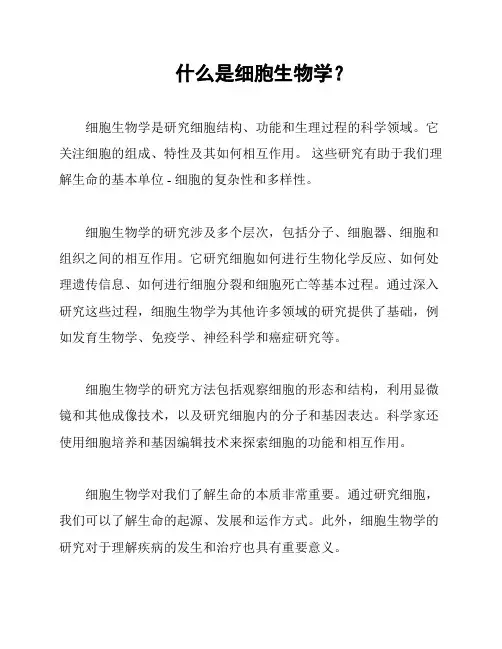
什么是细胞生物学?
细胞生物学是研究细胞结构、功能和生理过程的科学领域。
它关注细胞的组成、特性及其如何相互作用。
这些研究有助于我们理解生命的基本单位 - 细胞的复杂性和多样性。
细胞生物学的研究涉及多个层次,包括分子、细胞器、细胞和组织之间的相互作用。
它研究细胞如何进行生物化学反应、如何处理遗传信息、如何进行细胞分裂和细胞死亡等基本过程。
通过深入研究这些过程,细胞生物学为其他许多领域的研究提供了基础,例如发育生物学、免疫学、神经科学和癌症研究等。
细胞生物学的研究方法包括观察细胞的形态和结构,利用显微镜和其他成像技术,以及研究细胞内的分子和基因表达。
科学家还使用细胞培养和基因编辑技术来探索细胞的功能和相互作用。
细胞生物学对我们了解生命的本质非常重要。
通过研究细胞,我们可以了解生命的起源、发展和运作方式。
此外,细胞生物学的研究对于理解疾病的发生和治疗也具有重要意义。
细胞生物学是一个充满活力和不断发展的领域。
随着技术的进步和科学的发展,我们对细胞的认识将不断深化,这将推动我们在健康、医学和生物科学等领域取得更大的突破和进步。
参考文献:
- Alberts B, Johnson A, Lewis J, et al. Molecular Biology of the Cell. 4th edition. New York: Garland Science; 2002.
- Lodish H, Berk A, Zipursky SL, et al. Molecular Cell Biology. 4th edition. New York: W. H. Freeman; 2000.。
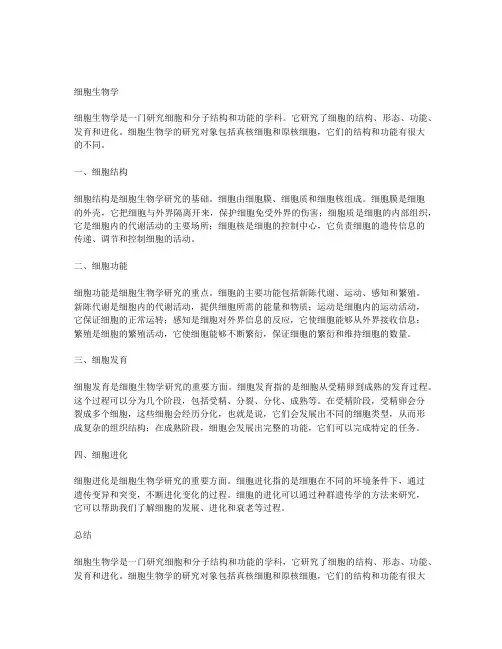
细胞生物学细胞生物学是一门研究细胞和分子结构和功能的学科。
它研究了细胞的结构、形态、功能、发育和进化。
细胞生物学的研究对象包括真核细胞和原核细胞,它们的结构和功能有很大的不同。
一、细胞结构细胞结构是细胞生物学研究的基础。
细胞由细胞膜、细胞质和细胞核组成。
细胞膜是细胞的外壳,它把细胞与外界隔离开来,保护细胞免受外界的伤害;细胞质是细胞的内部组织,它是细胞内的代谢活动的主要场所;细胞核是细胞的控制中心,它负责细胞的遗传信息的传递、调节和控制细胞的活动。
二、细胞功能细胞功能是细胞生物学研究的重点。
细胞的主要功能包括新陈代谢、运动、感知和繁殖。
新陈代谢是细胞内的代谢活动,提供细胞所需的能量和物质;运动是细胞内的运动活动,它保证细胞的正常运转;感知是细胞对外界信息的反应,它使细胞能够从外界接收信息;繁殖是细胞的繁殖活动,它使细胞能够不断繁衍,保证细胞的繁衍和维持细胞的数量。
三、细胞发育细胞发育是细胞生物学研究的重要方面。
细胞发育指的是细胞从受精卵到成熟的发育过程。
这个过程可以分为几个阶段,包括受精、分裂、分化、成熟等。
在受精阶段,受精卵会分裂成多个细胞,这些细胞会经历分化,也就是说,它们会发展出不同的细胞类型,从而形成复杂的组织结构;在成熟阶段,细胞会发展出完整的功能,它们可以完成特定的任务。
四、细胞进化细胞进化是细胞生物学研究的重要方面。
细胞进化指的是细胞在不同的环境条件下,通过遗传变异和突变,不断进化变化的过程。
细胞的进化可以通过种群遗传学的方法来研究,它可以帮助我们了解细胞的发展、进化和衰老等过程。
总结细胞生物学是一门研究细胞和分子结构和功能的学科,它研究了细胞的结构、形态、功能、发育和进化。
细胞生物学的研究对象包括真核细胞和原核细胞,它们的结构和功能有很大的不同。
细胞的结构包括细胞膜、细胞质和细胞核;细胞的功能包括新陈代谢、运动、感知和繁殖;细胞的发育可以分为受精、分裂、分化和成熟等几个阶段;细胞的进化是指细胞在不同的环境条件下,通过遗传变异和突变,不断进化变化的过程。
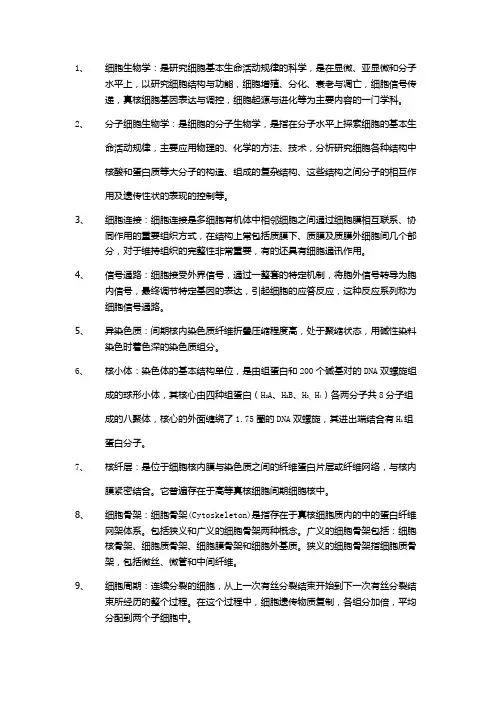
1、细胞生物学:是研究细胞基本生命活动规律的科学,是在显微、亚显微和分子水平上,以研究细胞结构与功能,细胞增殖、分化、衰老与凋亡,细胞信号传递,真核细胞基因表达与调控,细胞起源与进化等为主要内容的一门学科。
2、分子细胞生物学:是细胞的分子生物学,是指在分子水平上探索细胞的基本生命活动规律,主要应用物理的、化学的方法、技术,分析研究细胞各种结构中核酸和蛋白质等大分子的构造、组成的复杂结构、这些结构之间分子的相互作用及遗传性状的表现的控制等。
3、细胞连接:细胞连接是多细胞有机体中相邻细胞之间通过细胞膜相互联系、协同作用的重要组织方式,在结构上常包括质膜下、质膜及质膜外细胞间几个部分,对于维持组织的完整性非常重要,有的还具有细胞通讯作用。
4、信号通路:细胞接受外界信号,通过一整套的特定机制,将胞外信号转导为胞内信号,最终调节特定基因的表达,引起细胞的应答反应,这种反应系列称为细胞信号通路。
5、异染色质:间期核内染色质纤维折叠压缩程度高,处于聚缩状态,用碱性染料染色时着色深的染色质组分。
6、核小体:染色体的基本结构单位,是由组蛋白和200个碱基对的DNA双螺旋组成的球形小体,其核心由四种组蛋白(H2A、H2B、H3、H4)各两分子共8分子组成的八聚体,核心的外面缠绕了1.75圈的DNA双螺旋,其进出端结合有H1组蛋白分子。
7、核纤层:是位于细胞核内膜与染色质之间的纤维蛋白片层或纤维网络,与核内膜紧密结合。
它普遍存在于高等真核细胞间期细胞核中。
8、细胞骨架:细胞骨架(Cytoskeleton)是指存在于真核细胞质内的中的蛋白纤维网架体系。
包括狭义和广义的细胞骨架两种概念。
广义的细胞骨架包括:细胞核骨架、细胞质骨架、细胞膜骨架和细胞外基质。
狭义的细胞骨架指细胞质骨架,包括微丝、微管和中间纤维。
9、细胞周期:连续分裂的细胞,从上一次有丝分裂结束开始到下一次有丝分裂结束所经历的整个过程。
在这个过程中,细胞遗传物质复制,各组分加倍,平均分配到两个子细胞中。
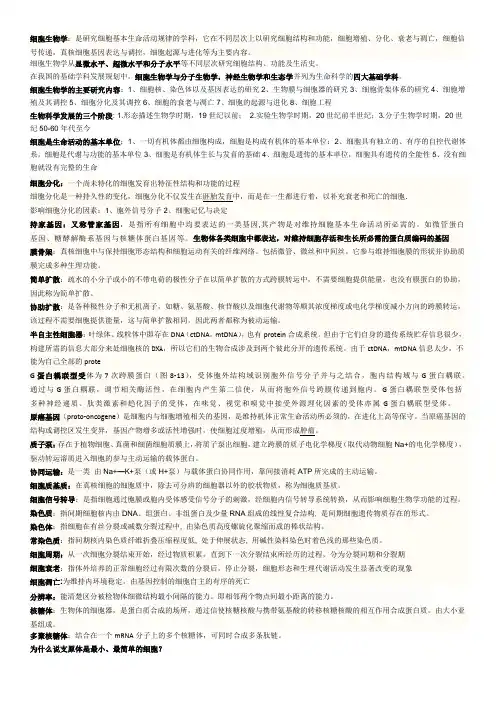
细胞生物学:是研究细胞基本生命活动规律的学科,它在不同层次上以研究细胞结构和功能,细胞增殖、分化、衰老与凋亡,细胞信号传递,真核细胞基因表达与调控,细胞起源与进化等为主要内容。
细胞生物学从显微水平、超微水平和分子水平等不同层次研究细胞结构、功能及生活史。
在我国的基础学科发展规划中,细胞生物学与分子生物学,神经生物学和生态学并列为生命科学的四大基础学科。
细胞生物学的主要研究内容:1、细胞核、染色体以及基因表达的研究2、生物膜与细胞器的研究3、细胞骨架体系的研究4、细胞增殖及其调控5、细胞分化及其调控6、细胞的衰老与凋亡7、细胞的起源与进化8、细胞工程生物科学发展的三个阶段: 1.形态描述生物学时期,19世纪以前;2.实验生物学时期,20世纪前半世纪;3.分子生物学时期,20世纪50-60年代至今细胞是生命活动的基本单位:1、一切有机体都由细胞构成,细胞是构成有机体的基本单位;2、细胞具有独立的、有序的自控代谢体系,细胞是代谢与功能的基本单位3、细胞是有机体生长与发育的基础4、细胞是遗传的基本单位,细胞具有遗传的全能性5、没有细胞就没有完整的生命细胞分化:一个尚未特化的细胞发育出特征性结构和功能的过程细胞分化是一种持久性的变化,细胞分化不仅发生在胚胎发育中,而是在一生都进行着,以补充衰老和死亡的细胞.影响细胞分化的因素:1、胞外信号分子2、细胞记忆与决定持家基因:又称管家基因,是指所有细胞中均要表达的一类基因,其产物是对维持细胞基本生命活动所必需的。
如微管蛋白基因、糖酵解酶系基因与核糖体蛋白基因等。
生物体各类细胞中都表达,对维持细胞存活和生长所必需的蛋白质编码的基因膜骨架:真核细胞中与保持细胞形态结构和细胞运动有关的纤维网络。
包括微管、微丝和中间丝。
它参与维持细胞膜的形状并协助质膜完成多种生理功能。
简单扩散:疏水的小分子或小的不带电荷的极性分子在以简单扩散的方式跨膜转运中,不需要细胞提供能量,也没有膜蛋白的协助,因此称为简单扩散。
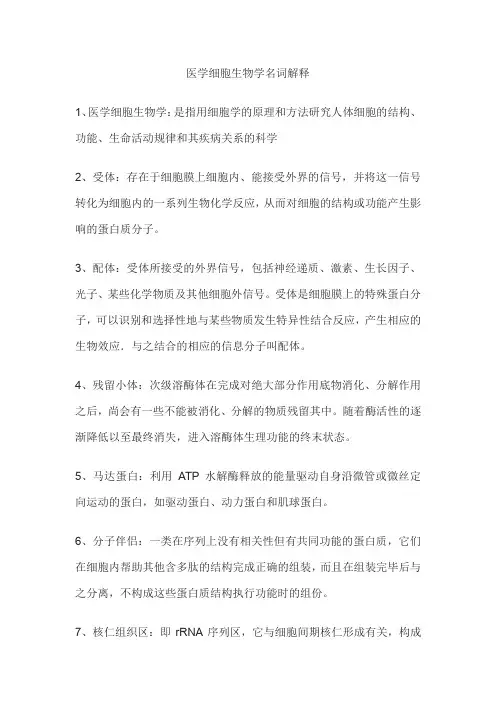
医学细胞生物学名词解释1、医学细胞生物学:是指用细胞学的原理和方法研究人体细胞的结构、功能、生命活动规律和其疾病关系的科学2、受体:存在于细胞膜上细胞内、能接受外界的信号,并将这一信号转化为细胞内的一系列生物化学反应,从而对细胞的结构或功能产生影响的蛋白质分子。
3、配体:受体所接受的外界信号,包括神经递质、激素、生长因子、光子、某些化学物质及其他细胞外信号。
受体是细胞膜上的特殊蛋白分子,可以识别和选择性地与某些物质发生特异性结合反应,产生相应的生物效应.与之结合的相应的信息分子叫配体。
4、残留小体:次级溶酶体在完成对绝大部分作用底物消化、分解作用之后,尚会有一些不能被消化、分解的物质残留其中。
随着酶活性的逐渐降低以至最终消失,进入溶酶体生理功能的终末状态。
5、马达蛋白:利用ATP 水解酶释放的能量驱动自身沿微管或微丝定向运动的蛋白,如驱动蛋白、动力蛋白和肌球蛋白。
6、分子伴侣:一类在序列上没有相关性但有共同功能的蛋白质,它们在细胞内帮助其他含多肽的结构完成正确的组装,而且在组装完毕后与之分离,不构成这些蛋白质结构执行功能时的组份。
7、核仁组织区:即rRNA序列区,它与细胞间期核仁形成有关,构成核仁的某一个或几个特定染色体片断。
这一片段的DNA转录为rRNA, rRNA所在处。
8、紧密连接:是相邻细胞间局部紧密结合,在连接处,两细胞膜发生点状融合,形成与外界隔离的封闭带,由相邻细胞的跨膜连接糖蛋白组成对应的封闭链,主要功能是封闭上皮cel间隙,防止胞外物质通过间隙进入组织,从而保证组织内环境的稳定性,紧密连接分布于各种上皮细胞管腔面,细胞间隙的顶端。
9、桥粒:上皮细胞等细胞间结合的一种形式,是细胞膜上直径约为0.5微米的圆形区域,在切面上可以看到二个相连的细胞膜之间有相距20—25毫微米严格平行的细胞间隙。
桥粒有增强细胞间结合的效能。
10、粘着带:粘着带连接位于上皮细胞紧密连接的下方,靠钙粘着蛋白同肌动蛋白相互作用,将两个细胞连接起来。

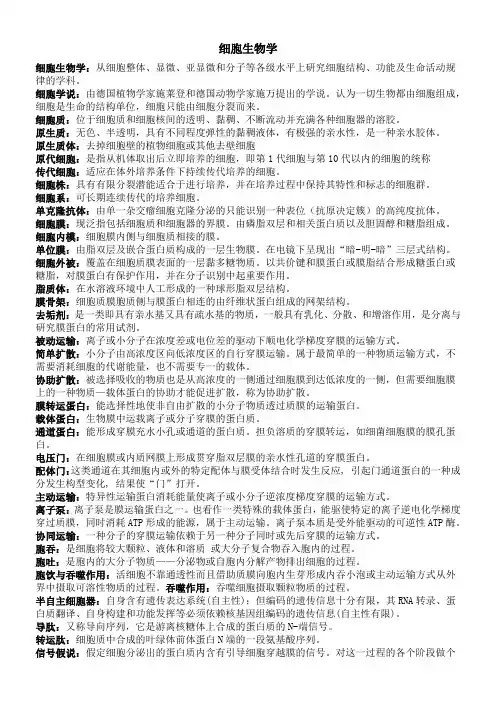
细胞生物学细胞生物学:从细胞整体、显微、亚显微和分子等各级水平上研究细胞结构、功能及生命活动规律的学科。
细胞学说:由德国植物学家施莱登和德国动物学家施万提出的学说。
认为一切生物都由细胞组成,细胞是生命的结构单位,细胞只能由细胞分裂而来。
细胞质:位于细胞质和细胞核间的透明、黏稠、不断流动并充满各种细胞器的溶胶。
原生质:无色、半透明,具有不同程度弹性的黏稠液体,有极强的亲水性,是一种亲水胶体。
原生质体:去掉细胞壁的植物细胞或其他去壁细胞原代细胞:是指从机体取出后立即培养的细胞,即第1代细胞与第10代以内的细胞的统称传代细胞:适应在体外培养条件下持续传代培养的细胞。
细胞株:具有有限分裂潜能适合于进行培养,并在培养过程中保持其特性和标志的细胞群。
细胞系:可长期连续传代的培养细胞。
单克隆抗体:由单一杂交瘤细胞克隆分泌的只能识别一种表位(抗原决定簇)的高纯度抗体。
细胞膜:现泛指包括细胞质和细胞器的界膜。
由磷脂双层和相关蛋白质以及胆固醇和糖脂组成。
细胞内模:细胞膜内侧与细胞质相接的膜。
单位膜:由脂双层及嵌合蛋白质构成的一层生物膜。
在电镜下呈现出“暗-明-暗”三层式结构。
细胞外被:覆盖在细胞质膜表面的一层黏多糖物质。
以共价键和膜蛋白或膜脂结合形成糖蛋白或糖脂,对膜蛋白有保护作用,并在分子识别中起重要作用。
脂质体:在水溶液环境中人工形成的一种球形脂双层结构。
膜骨架:细胞质膜胞质侧与膜蛋白相连的由纤维状蛋白组成的网架结构。
去垢剂:是一类即具有亲水基又具有疏水基的物质,一般具有乳化、分散、和增溶作用,是分离与研究膜蛋白的常用试剂。
被动运输:离子或小分子在浓度差或电位差的驱动下顺电化学梯度穿膜的运输方式。
简单扩散:小分子由高浓度区向低浓度区的自行穿膜运输。
属于最简单的一种物质运输方式,不需要消耗细胞的代谢能量,也不需要专一的载体。
协助扩散:被选择吸收的物质也是从高浓度的一侧通过细胞膜到达低浓度的一侧,但需要细胞膜上的一种物质—载体蛋白的协助才能促进扩散,称为协助扩散。
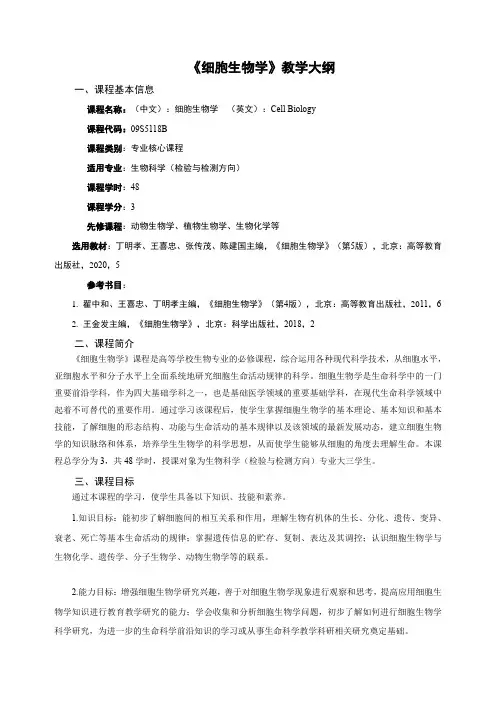
《细胞生物学》教学大纲一、课程基本信息课程名称:(中文):细胞生物学(英文):Cell Biology课程代码:09S5118B课程类别:专业核心课程适用专业:生物科学(检验与检测方向)课程学时:48课程学分:3先修课程:动物生物学、植物生物学、生物化学等选用教材:丁明孝、王喜忠、张传茂、陈建国主编,《细胞生物学》(第5版),北京:高等教育出版社,2020,5参考书目:1. 翟中和、王喜忠、丁明孝主编,《细胞生物学》(第4版),北京:高等教育出版社,2011,62. 王金发主编,《细胞生物学》,北京:科学出版社,2018,2二、课程简介《细胞生物学》课程是高等学校生物专业的必修课程,综合运用各种现代科学技术,从细胞水平,亚细胞水平和分子水平上全面系统地研究细胞生命活动规律的科学。
细胞生物学是生命科学中的一门重要前沿学科,作为四大基础学科之一,也是基础医学领域的重要基础学科,在现代生命科学领域中起着不可替代的重要作用。
通过学习该课程后,使学生掌握细胞生物学的基本理论、基本知识和基本技能,了解细胞的形态结构、功能与生命活动的基本规律以及该领域的最新发展动态,建立细胞生物学的知识脉络和体系,培养学生生物学的科学思想,从而使学生能够从细胞的角度去理解生命。
本课程总学分为3,共48学时,授课对象为生物科学(检验与检测方向)专业大三学生。
三、课程目标通过本课程的学习,使学生具备以下知识、技能和素养。
1.知识目标:能初步了解细胞间的相互关系和作用,理解生物有机体的生长、分化、遗传、变异、衰老、死亡等基本生命活动的规律;掌握遗传信息的贮存、复制、表达及其调控;认识细胞生物学与生物化学、遗传学、分子生物学、动物生物学等的联系。
2.能力目标:增强细胞生物学研究兴趣,善于对细胞生物学现象进行观察和思考,提高应用细胞生物学知识进行教育教学研究的能力;学会收集和分析细胞生物学问题,初步了解如何进行细胞生物学科学研究,为进一步的生命科学前沿知识的学习或从事生命科学教学科研相关研究奠定基础。
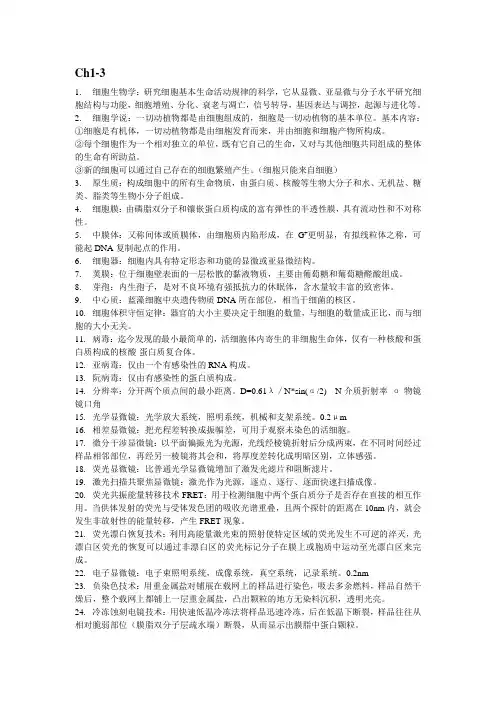
Ch1-31.细胞生物学:研究细胞基本生命活动规律的科学,它从显微、亚显微与分子水平研究细胞结构与功能,细胞增殖、分化、衰老与凋亡,信号转导,基因表达与调控,起源与进化等。
2.细胞学说:一切动植物都是由细胞组成的,细胞是一切动植物的基本单位。
基本内容:①细胞是有机体,一切动植物都是由细胞发育而来,并由细胞和细胞产物所构成。
②每个细胞作为一个相对独立的单位,既有它自己的生命,又对与其他细胞共同组成的整体的生命有所助益。
③新的细胞可以通过自己存在的细胞繁殖产生。
(细胞只能来自细胞)3.原生质:构成细胞中的所有生命物质,由蛋白质、核酸等生物大分子和水、无机盐、糖类、脂类等生物小分子组成。
4.细胞膜:由磷脂双分子和镶嵌蛋白质构成的富有弹性的半透性膜,具有流动性和不对称性。
5.中膜体:又称间体或质膜体,由细胞质内陷形成,在G+更明显,有拟线粒体之称,可能起DNA复制起点的作用。
6.细胞器:细胞内具有特定形态和功能的显微或亚显微结构。
7.荚膜:位于细胞壁表面的一层松散的黏液物质,主要由葡萄糖和葡萄糖醛酸组成。
8.芽孢:内生孢子,是对不良环境有强抵抗力的休眠体,含水量较丰富的致密体。
9.中心质:蓝藻细胞中央遗传物质DNA所在部位,相当于细菌的核区。
10.细胞体积守恒定律:器官的大小主要决定于细胞的数量,与细胞的数量成正比,而与细胞的大小无关。
11.病毒:迄今发现的最小最简单的,活细胞体内寄生的非细胞生命体,仅有一种核酸和蛋白质构成的核酸-蛋白质复合体。
12.亚病毒:仅由一个有感染性的RNA构成。
13.阮病毒:仅由有感染性的蛋白质构成。
14.分辨率:分开两个质点间的最小距离。
D=0.61λ/N*sin(α/2) N介质折射率α-物镜镜口角15.光学显微镜:光学放大系统,照明系统,机械和支架系统。
0.2μm16.相差显微镜:把光程差转换成振幅差,可用于观察未染色的活细胞。
17.微分干涉显微镜:以平面偏振光为光源,光线经棱镜折射后分成两束,在不同时间经过样品相邻部位,再经另一棱镜将其会和,将厚度差转化成明暗区别,立体感强。
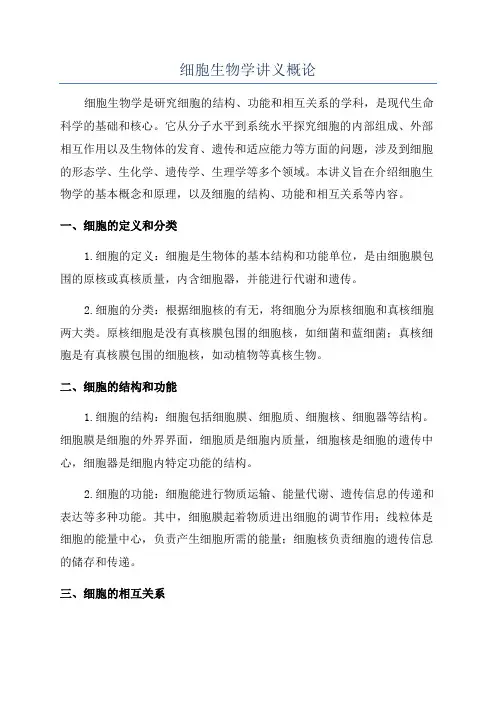
细胞生物学讲义概论细胞生物学是研究细胞的结构、功能和相互关系的学科,是现代生命科学的基础和核心。
它从分子水平到系统水平探究细胞的内部组成、外部相互作用以及生物体的发育、遗传和适应能力等方面的问题,涉及到细胞的形态学、生化学、遗传学、生理学等多个领域。
本讲义旨在介绍细胞生物学的基本概念和原理,以及细胞的结构、功能和相互关系等内容。
一、细胞的定义和分类1.细胞的定义:细胞是生物体的基本结构和功能单位,是由细胞膜包围的原核或真核质量,内含细胞器,并能进行代谢和遗传。
2.细胞的分类:根据细胞核的有无,将细胞分为原核细胞和真核细胞两大类。
原核细胞是没有真核膜包围的细胞核,如细菌和蓝细菌;真核细胞是有真核膜包围的细胞核,如动植物等真核生物。
二、细胞的结构和功能1.细胞的结构:细胞包括细胞膜、细胞质、细胞核、细胞器等结构。
细胞膜是细胞的外界界面,细胞质是细胞内质量,细胞核是细胞的遗传中心,细胞器是细胞内特定功能的结构。
2.细胞的功能:细胞能进行物质运输、能量代谢、遗传信息的传递和表达等多种功能。
其中,细胞膜起着物质进出细胞的调节作用;线粒体是细胞的能量中心,负责产生细胞所需的能量;细胞核负责细胞的遗传信息的储存和传递。
三、细胞的相互关系2.细胞的组织和器官:相同类型的细胞可以组织成组织,不同类型的组织可以组合形成器官,不同器官之间可以组成一个完整的生物体。
四、细胞的繁殖和分化1.细胞的繁殖:细胞能够通过有丝分裂和无丝分裂两种方式进行繁殖。
有丝分裂是指细胞对核和细胞质进行同步复制,然后进行分裂;无丝分裂则是细胞直接进行分裂,没有核和细胞质的复制过程。
2.细胞的分化:细胞分化是指细胞通过表达不同基因,进而形成不同的形态和功能。
细胞的分化过程是由基因表达调控网络控制的,而细胞分化后会形成不同功能的细胞类型,如肌肉细胞、神经细胞等。
细胞生物学是生命科学的基石,对于我们了解生命的本质、解读疾病机制和开发新药都具有重要意义。

细胞生物学第五版翟中和pdf•细胞生物学概述•细胞的结构与功能•细胞的代谢与调控•细胞的生长、分裂与分化•细胞的遗传、变异与进化•细胞生物学的研究方法与技术01细胞生物学概述细胞生物学的定义与研究对象细胞生物学的定义研究对象细胞生物学的发展历史与现状发展历史现状细胞生物学的研究意义与价值揭示生命活动的规律为医学提供理论基础推动生物技术的发展02细胞的结构与功能细胞膜的主要成分细胞膜的结构细胞膜的功能细胞质的主要成分01细胞质的结构02细胞质的功能031 2 3细胞核的主要成分细胞核的结构细胞核的功能高尔基体由扁平囊和小泡组成,单层膜结构。
功能是对蛋白质进行加工、分类和包装,然后分门别类地送到细胞特定的部位或分泌到细胞外。
线粒体由双层膜包被,内膜向内折叠形成嵴,嵴上有基粒;基质中含有与有氧呼吸有关的酶。
功能是进行有氧呼吸的主要场所,为细胞代谢提供能量。
叶绿体由双层膜包被,内部有许多基粒,基粒与基粒之间充满基质。
功能是进行光合作用的场所,将光能转化为化学能并储存在有机物中。
内质网由单层膜连接而成的网状结构,分为粗面内质网和光面内质网两种。
功能是蛋白质合成和加工以及脂质合成的车间。
细胞器的结构与功能03细胞的代谢与调控ATP的合成与分解释放能量供细胞使用。
呼吸作用光合作用蛋白质代谢脂质代谢糖类代谢01 02 03受体介导的信号传导细胞内信号传导通路细胞周期与细胞生长的调控细胞的信号传导与调控04细胞的生长、分裂与分化细胞生长的概念细胞增殖的方式细胞周期030201细胞的生长与增殖无丝分裂真核细胞的一种分裂方式,过程简单,无纺锤丝和染色体的出现。
有丝分裂真核细胞分裂的主要方式,包括前期、中期、后期和末期,确保遗传物质的平均分配。
减数分裂生殖细胞的分裂方式,包括两次连续的细胞分裂,最终产生遗传物质减半的配子。
细胞的分裂方式及过程030201细胞分化的概念同一来源的细胞逐渐产生出形态结构、功能特征各不相同的细胞类群的过程。
细胞生物学第一章绪论一.细胞生物学研究的对象及目前研究的重要方面和进展1.什么是细胞生物学(研究对象)?细胞是生物形态结构和生命活动的基本单位。
那么我们探索生物体的生命必然要深入细胞中去进行研究。
细胞学就是研究细胞的结构、功能及其生活史的科学。
早期的细胞学是以研究细胞的形态和结构为核心的。
细胞生物学与细胞学的区别是什么呢?细胞生物学是由细胞学发展而来的,但它又不同细胞学。
无论从对细胞研究的范围和深度都远远超出了早期细胞学的研究水平。
现代的细胞学,即细胞生物学是生物各门学科——特别是细胞学、生物化学和遣传学发展到分子水平而汇流到一起的产物。
它是一门综合性学科,也是一门基础学科。
在形态描述方面已远远超出光镜下可见的结构水平;在功能方面也超越了生理变化的描述时期。
随着分子生物学的发展、新方法、新技术的不断涌现,对细胞的研究已从细胞全体和超微结构深入到分子结构三个不同层次中去了,因为生物体本身就是一个多层次的实体,这也是必然的发展规律。
目前已将细胞的整体活动水平、亚细胞结构和分子水平三个方面的研究有机的结合起来,以动态的观点来观察细胞和细胞器的结构和功能以探索细胞的基本活动。
它不仅是孤立地研究一个个细胞器和生物大分子,一个个生命现象,而是研究它们之间变化过程,它们之间的相互关系,以及与环境的相互关系。
概括起来说,细胞生物学是在显微水平、亚显微水平和分子水平三个层次上探讨细胞生命活动及其机制与规律的学科。
在研究范围上已大大超出了过去细胞学内容,改称“细胞生物学”(cell biology)。
2.当前细胞生物学研究的几个重要方面和发展概念。
生物结构的不同层次水平:范畴①分辨力 0.1mm (100μm)以上解剖学、结构器官② 100μm → 10 μm 组织学组织(各种光镜)③ 10 μm → 0.2μm 细胞学细胞、细菌④ 200nm → 1nm 亚显微形态学、超微结构、分子生物学⑤小于1nm 分子和原子结构、原子的排列<1> 细胞超微结构及功能60—70年代中基本搞清超微结构分辨力0.4nm → 0.2μm 光镜/人眼分辨力增加500倍,电镜/光镜增加500倍。
1、细胞生物学:是研究细胞基本生活规律的科学,它从不同层次上主要研究细胞结构与功能,细胞增殖、分化、衰老与凋亡,细胞信号转导、细胞基因表达与调控,细胞起源与进化2、单克隆抗体:单克隆细胞合成的一种决定簇的抗体3、细胞膜骨架:指细胞质膜下与膜蛋白相连的由纤维蛋白组成的网架结构,它参与维持细胞质膜的形状并协助质膜完成多种生理功能(由锚蛋白、血影蛋白及带4、1蛋白组成)4、被动运输:是指通过简单扩散或协助扩散实现物质由高浓度向低浓度方向的跨膜运输5、主动运输:是由载体蛋白所介导的物质逆浓度梯度或电化学梯度由低浓度一侧向高浓度一侧进行跨膜转运的方式6、协同转运:是一类由钠钾泵与载体蛋白协同作用,靠间接消耗ATP所完成的主动运输方式7、胞吞作用:是通过细胞质膜内缩形成囊泡称胞吞泡将外界物质裹进并输入细胞的过程8、胞吐作用:是将细胞内的分泌泡或其他膜泡中的物质通过细胞质膜运出细胞的过程9、细胞质基质:在真核细胞的细胞质中,除去可分辨的细胞器以外的胶状物质10、信号假说:分泌性蛋白N端序列作为信号肽,指导分泌性蛋白到内质网膜上合成,然后在信号肽引导下蛋白质边合成边通过异位子蛋白复合体进入内质网腔,在蛋白质合成结束之前,信号肽被切除11细胞通讯:是指一个细胞发出的信息通过介质传到另一个细胞并与靶细胞相应的受体相互作用,然后通过细胞细胞信号转导产生胞内一系列生理生化变化,最终表现为细胞整体的生物学效应过程12、受体:是一种能够识别和选择性结合某种配体的大分子,绝大多数已经鉴定的受体都是蛋白质且多为糖蛋白,多数受体为糖脂,有的为糖蛋白和糖脂组成的复合物13、常染色质:指间期细胞核内染色质纤维折叠压缩程度相对低相对处于伸展状态,用碱性染料染色时着色浅的那些染色质14、异染色质:指间期核中,染色质纤维折叠压缩程度高,处于压缩状态,用碱性染料染色时着色深的那些染色质15、细胞周期:(G1期,S期,G2期,M期)从一次细胞分裂结束开始,经过物质积累过程,知道下一次细胞分裂结束为止16、细胞促成熟因子:M期细胞可以诱导PCC,提示在M期细胞中可能存在一种诱导染色体凝集的因子17、细胞凋亡(程序性细胞死亡):由体内外因素触发细胞内预存的死亡程序而导致的细胞死亡的过程18、细胞坏死:当细胞受到意外损伤如极端的物理、化学因素或严重的病理性刺激的情况下,细胞质出现空泡,细胞膜破损,细胞内含物及染色质片段释放到胞外,引起周围组织的炎症化19、细胞分化:在个体发育中,有一种相同的细胞类型经细胞分裂后逐渐在形态、结构和功能上形成稳定差异,产生不同的细胞类型的过程。
细胞生物学第一章绪论一、细胞生物学的研究对象、内容和任务1.细胞生物学的研究对象细胞生物学是研究细胞生命体活动基础规律的一门学科,是现代生命科学的基础学科之一,其研究对象是细胞。
细胞是除病毒以外的所有生物体结构和功能的基本组成单位。
细胞学是指对细胞的研究,从显微和亚显微两个结构层次对细胞的形态结构、生理功能及其生活史的研究。
概括地说,细胞生物学是以细胞为研究对象,应用现代物理学、化学、实验生物学、生物化学及分子生物学的技术和方法,从细胞整体水平、亚显微水平和分子水平三个层次上研究细胞的结构及其生命活动规律的科学。
其研究内容包括细胞各部分的结构和功能,细胞增殖、分化、衰老与凋亡,细胞信号传递,真核细胞基因表达与调控,细胞起源与进化等。
研究的目的不仅在于阐明细胞各种生命活动的现象和本质,而且还要利用和控制其活动现象和规律,为生产实践服务,造福于人类和社会。
2.细胞生物学的研究任务细胞生物学的研究任务是将细胞整体水平、亚显微水平和分子水平三个层次的研究有机地结合起来,以动态的观点考察细胞及细胞器的结构和功能,全面而深人地解读细胞的各项生命活动。
在理论研究方面,采取分析与综合相结合的方法,在细胞显微、亚显微和分子结构三个不同层次上,把结构与功能统一起来进行研究。
在形态方面,不仅要描述细胞的显微结构,而且要用新的工具和方法,观察与分析细胞内部的亚显微结构、分子结构以及各种结构之间的变化过程,进而阐明细胞生命活动的结构基础;在功能方面,不仅要研究细胞内各部分的化学组成和新陈代谢的动态,而且还要研究它们之间的关系和相互作用,进而揭示细胞的生长、分裂、分化、运动、衰老与死亡、遗传与变异,以及信号的传导等生命活动的现象和规律。
在实践应用方面,重视对实际问题的研究。
当今蓬勃发展的生物技术就是以细胞生物学为基础的。
现代生物技术包括细胞工程、基因工程、酶工程、发酵工程和蛋白质工程等。
细胞工程是指应用细胞生物学和分子生物学的原理和方法,通过某种工程学手段,在细胞水平或亚细胞水平上,按照人们的意愿来改变细胞内的遗传物质或获得细胞产品的一门科学技术。
细胞生物学细胞生物学(Cell biology)是一门从细胞的显微结构、超微结构和分子结构的各级水平研究细胞的结构与功能的关系,从而探索细胞生长、发育、分化、繁殖、遗传、变异、代谢、衰亡、及进化等各种生命现象规律的科学。
其核心问题是将遗传与发育在细胞水平上结合起来。
细胞生物学的历史可以划分为三个主要的阶段:第一阶段:从16世纪末—19世纪30年代,是细胞发现和细胞知识的积累阶段。
第二阶段:从19世纪30年代—20世纪中期,细胞学说形成,主要进行细胞显微形态的研究。
第三阶段:从20世纪50年代—60年代以来,以细胞超微结构、核型、带型研究为主要内容。
80年代分子克隆技术的成熟到当前,细胞生物学与分子生物学的结合愈来愈紧密,基因调控、信号转导、细胞分化和凋亡、肿瘤生物学等领域成为当前的主流研究内容。
“细胞学说”的基本内容:1、细胞是有机体,一切动植物都是由细胞发育而来, 并由细胞和细胞产物所构成。
2、每个细胞作为一个相对独立的单位,既有它“自己的”生命,又对与其它细胞共同组成的整体的生命有所助益。
3、新的细胞可以通过老的细胞繁殖产生。
一切有机体都由细胞构成(除病毒是非细胞形态的生命体外),细胞是构成有机体的基本单位。
细胞的基本共性:1、所有的细胞都有相似的化学组成2、脂—蛋白体系的生物膜:所有的细胞表面均有由磷脂双分子层与镶嵌蛋白质构成的生物膜,即细胞质膜。
3、DNA—RNA的遗传装置:所有的细胞都含有两种核酸,即DNA与RNA作为遗传信息复制与转录的载体。
4、作为蛋白质合成的机器─核糖体,毫无例外地存在于一切细胞内。
5、一分为二的分裂方式:所有细胞的增殖都以一分为二的方式进行分裂。
原核细胞没有核膜,DNA为裸露的环状分子,通常没有结合蛋白。
没有恒定的内膜系统,核糖体为70S型。
通常称为细菌.支原体:它是最小最简单的细胞。
大小0.2~0.3μm,可通过滤菌器、无细胞壁。
细胞膜中胆固醇含量较多,约占36%,凡能作用于胆固醇的物质(如二性霉素B、皂素等)均可引起支原体膜的破坏而使支原体死亡。
细胞生物学cell biology定义:从细胞整体、显微、亚显微和分子等各级水平上研究细胞结构、功能及生命活动规律的学科。
细胞生物学(cell biology)是在显微、亚显微和分子水平三个层次上,研究细胞的结构、功能和各种生命规律的一门科学。
细胞生物学由Cytology发展而来,Cytology是关于细胞结构与功能(特别是染色体)的研究。
现代细胞生物学从显微水平,超微水平和分子水平等不同层次研究细胞的结构、功能及生命活动。
在我国基础学科发展规划中,细胞生物学与分子生物学,神经生物学和生态学并列为生命科学的四大基础学科。
简介:细胞生物学是以细胞为研究对象, 从细胞的整体水平、亚显微水平、分子水平等三个层次,(斯.诺.美.A11-走在生物医学的最前沿)以动态的观点, 研究细胞和细胞器的结构和功能、细胞的生活史和各种生命活动规律的学科。
细胞生物学是现代生命科学的前沿分支学科之一,主要是从细胞的不同结构层次来研究细胞的生命活动的基本规律。
从生命结构层次看,细胞生物学位于分子生物学与发育生物学之间,同它们相互衔接,互相渗透。
运用近代物理学和化学的技术成就和分子生物学的方法、概念,在细胞水平上研究生命活动的科学,其核心问题是遗传与发育的问题。
细胞生物学简史从研究内容来看细胞生物学的发展可分为三个层次,即:显微水平、超微水平和分子水平。
从时间纵轴来看细胞生物学的历史大致可以划分为四个主要的阶段:第一阶段:从16世纪后期到19世纪30年代,是细胞发现和细胞知识的积累阶段。
通过对大量动植物的观察,人们逐渐意识到不同的生物都是由形形色色的细胞构成的。
第二阶段:从19世纪30年代到20世纪初期,细胞学说形成后,开辟了一个新的研究领域,在显微水平研究细胞的结构与功能是这一时期的主要特点。
形态学、胚胎学和染色体知识的积累,使人们认识了细胞在生命活动中的重要作用。
1893年Hertwig的专著《细胞与组织》(Die Zelle und die Gewebe)出版,标志着细胞学的诞生。
名词解释原生质:原生质一词原指细胞的全部活性物质,从现代概念来说它包括质膜、细胞质和细胞核(或拟核)。
质膜:是细胞表面的单位膜。
细胞质:质膜与核被膜之间的原生质。
细胞器:具有特定形态和功能的显微或亚显微结构称为细胞器细胞质基质:细胞质中除细胞器以外的部分又称为或胞质溶胶,其体积约占细胞质的一半。
细胞核:真核细胞中最大的由膜包围的最重要的细胞器。
是遗传物质贮存、复制和转录的场所。
主要包括核被膜、核基质、染色质和核仁四部分。
脂质体:是一种人工膜。
在水中搅动后形成,双层或单层脂分子球体外在/外周膜蛋白:通过与膜脂的极性头部或内在膜蛋白的离子相互作用和形成氢键与膜的内、外表面弱结合的膜蛋白。
内在膜蛋白:又称整合蛋白、跨膜蛋白,部分或全部镶嵌在细胞膜中或内外两侧,以非极性氨基酸与脂双分子层的非极性疏水区相互作用而结合在质膜上。
脂锚定膜蛋白:是通过与之共价相连的脂分子插入膜的脂双分子中,从而锚定在细胞质膜上的一类膜蛋白。
膜骨架:质膜下起支撑作用的网络结构血影:是指人的红细胞经低渗处理后,质膜破裂剩下保持原来的形态和大小的细胞膜结构。
简单扩散小分子由高浓度区向低浓度区的自行穿膜运输。
不需要消耗细胞的代谢能量,也不需要专一的载体。
被动运输/协助扩散离子或小分子在浓度差或电位差的驱动下顺电化学梯度穿膜的运输方式。
主动运输特异性运输蛋白消耗能量使离子或小分子逆浓度梯度穿膜的运输方式。
胞吞作用通过质膜内陷形成膜泡,将物质摄入细胞内的现象。
包括吞噬和胞饮。
胞饮作用活细胞不靠通透性而且借助质膜向胞内生芽形成内吞小泡或主动运输方式从外界中摄取可溶性物质的过程。
吞噬作用吞噬细胞摄取颗粒物质的过程。
细胞质基质是除去能分辨的细胞器和颗粒以外的细胞质中胶态的基底物质。
内膜系统真核细胞中,在结构、功能上具有连续性的、由膜围成的细胞器或结构。
包括内质网、高尔基体、溶酶体、内体和分泌泡以及核膜等膜结构,但不包括线粒体和叶绿体。
内质网应激由其他因素导致得内质网功能的内稳态失衡, 形成内质网应激。
矿产资源开发利用方案编写内容要求及审查大纲
矿产资源开发利用方案编写内容要求及《矿产资源开发利用方案》审查大纲一、概述
㈠矿区位置、隶属关系和企业性质。
如为改扩建矿山, 应说明矿山现状、
特点及存在的主要问题。
㈡编制依据
(1简述项目前期工作进展情况及与有关方面对项目的意向性协议情况。
(2 列出开发利用方案编制所依据的主要基础性资料的名称。
如经储量管理部门认定的矿区地质勘探报告、选矿试验报告、加工利用试验报告、工程地质初评资料、矿区水文资料和供水资料等。
对改、扩建矿山应有生产实际资料, 如矿山总平面现状图、矿床开拓系统图、采场现状图和主要采选设备清单等。
二、矿产品需求现状和预测
㈠该矿产在国内需求情况和市场供应情况
1、矿产品现状及加工利用趋向。
2、国内近、远期的需求量及主要销向预测。
㈡产品价格分析
1、国内矿产品价格现状。
2、矿产品价格稳定性及变化趋势。
三、矿产资源概况
㈠矿区总体概况
1、矿区总体规划情况。
2、矿区矿产资源概况。
3、该设计与矿区总体开发的关系。
㈡该设计项目的资源概况
1、矿床地质及构造特征。
2、矿床开采技术条件及水文地质条件。